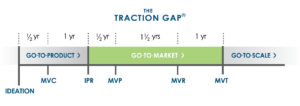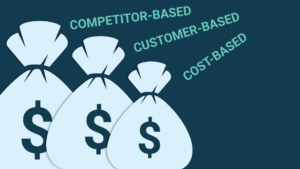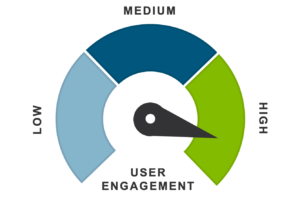On the Hunt for Users and Usage
February 11, 2019
PUBLISHED BY Wildcat Venture Partners
By the time your startup has reached a Minimum Viable Product (MVP), it’s already come a long way.

What was once simply an idea now has a team behind it, has market validation, and is picking up steam. The team has defined (or redefined) a Minimum Viable Category (MVC), performed statistically valid research, and has raised a Seed or even a full round of financing. It has also placed the first version of a product — Initial Product Release (IPR) — into the hands of a few consumers or business users, captured their feedback, and revised features and/or positioning based on that feedback.
Your team is learning how to become “market-first”; that is, you are focused on using quantitative and qualitative feedback and other data from customers, non-customers, partners, etc. (the overall market) to make all your product, pricing, and positioning decisions.
Now, all energy needs to be focused on creating a product that your team can aggressively take to market. And there’s no time to waste: Industry data suggests that after reaching IPR, you have only about six months to reach MVP.

Our advice for the pre-MVP stage can be broken down into four (interconnected) areas: The Beta program, pricing strategy, user feedback, and engagement analysis.
Beta Program
To have any chance of reaching MVP, startups must develop and implement a well-functioning Beta program. This lets them flush out bugs, polish the user interface, and take care of some of that technical debt they’ve accumulated along the way.
MVP traditionally has been defined as the minimum number of features for which a customer is willing to pay. At Wildcat, we see things a little differently. With B2B products, we like to see companies pay for Beta software. If they’ll pay for the Beta, you can be confident that you’re solving an important problem and delivering value to people who need it. You know that you’re developing something people want.

And, even if charging for the Beta version sounds too aggressive, this is still the time to get serious about establishing and monitoring Daily Active Usage (DAU) metrics.
For B2C startups, the acid test during the Beta phase is usually how often consumers use your product. This is why DAU rates are so important, especially for consumer applications, which intend to generate revenue via advertising.
For both B2B and B2C startups, usage and usage rates are the metrics that Wildcat recommends companies closely monitor, unless they have a really good reason to choose an alternative.
At this point, everyone on your product team should be focused on the Beta program. Those with marketing, product marketing, and customer support skills should be completing market engineering tasks such as preparing company launch plans (e.g. media strategy, initial revenue systems, support systems, etc.).
Pricing Strategy
Revenue will be the standard by which all startups will ultimately be valued. For this reason, teams should begin experimenting with revenue/pricing models earlier vs later.
You don’t need to lock anything in, but this is the period to test the market and gain a sense of what will and what won’t work. A simple way to do this is to craft a basic landing page attached to a digital ad in LinkedIn that acts as a one-question survey and asks, “What would you pay for this product?”

Many B2B startups attempt to use Return on Investment (ROI) calculations when developing their pricing and discount models. This approach is okay, but it needs to be balanced against other products that may already exist in the category. If you attempt to price your product five times higher than an alternative in the market, and that alternative is “good enough”, you won’t succeed. You can’t determine price in a vacuum.
Knowing the product features and capabilities of other companies in or near your category, their pricing, and other terms (e.g., Service Level Agreements) is a mandatory best practice if you intend to be a market-first company.
Today, there are great products available for tracking competitors: Trackmaven, AirPR, or even Google Alerts. And knowing what your competitors or potential competitors are doing at all times is not a bonus, it’s mission-critical. If you think you don’t have any competitors, then we hate to break it to you, but you’re wrong. The status quo, for example, is a powerful competitor.
User Feedback
Startups must design a Beta program that can effectively capture, process, and share data-driven feedback from business/consumer product use. Amplify, MixPanel, Pendo and Totango can all provide you with various forms of daily product usage data and analytics that can be used to track user behavior.

During this phase, make sure the team is also focused upon the qualitative feedback. You can’t rely solely upon metrics. Qualitative feedback only comes from meeting face-to-face with end-users, watching how they use the product and where they get stuck, and being ruthless about delivering a quality user experience (UX).
Investing in face-to-face time enables businesses and consumers to provide you with information not just about how often they use your product, but how they “feel” about using it. You need this feedback because how users feel will determine whether or not they recommend your product to other potential customers. People will be honest with you, if you ask them to be. And it’s the only way to find out what you’re doing right and perhaps more importantly, what you’re doing wrong.
Engagement Analysis
Releasing your product is great. High-fives all round in the office; a speech from the CEO. But now you must ask the really important question: How are we doing?
 During this phase, you need to have your engagement analysis strategy up and running. Engagement is critical. If no one continues to use your product or feature, you’re in trouble, no matter how many people initially tried it. At Wildcat, we’ve noticed that some startups — typically B2Bs — don’t gather any of this usage data. Not gathering data can be a deadly mistake.
During this phase, you need to have your engagement analysis strategy up and running. Engagement is critical. If no one continues to use your product or feature, you’re in trouble, no matter how many people initially tried it. At Wildcat, we’ve noticed that some startups — typically B2Bs — don’t gather any of this usage data. Not gathering data can be a deadly mistake.
On the other end of the spectrum, some startups gather a ridiculous amount of data (e.g. clickstream), and don’t know what to do with it all. Too little data isn’t good and too much is simply overkill. It’s up to you to decide the amount and type of data you need to base your product decisions upon. But have a plan, and then execute it.
Declaring MVP
If you are smart about managing your Beta program, developing your pricing strategy, capturing user feedback and performing engagement analysis, you should reach the point where you can confidently declare MVP.
At this point, your company should have worked with many consumers/businesses and you should be confident — not from a gut feeling, but from data and feedback — that you have the right value propositions, initial pricing, and category positioning so you can begin marketing and selling your product in earnest.
If you are ready to declare MVP, you are — or you are rapidly becoming — a truly market-first team. You listen to market signals. And you have proven you have the right market/product fit because companies have indicated they are willing to pay — or have already paid — to use your product. In the case of consumers, they are actively using your product, and downloads and DAUs are increasing due to word-of-mouth and other virality programs you’ve developed.
Now, here is a very important point that you must internalize: You have complete control over when you declare MVP. The decision to pull the trigger is a vitally critical decision point for you and your startup. Few investors will fault you if you decide to take an extra six months to make that user experience really shine.
But, once you do formally declare MVP, investors will scrutinize and compare your growth (traction) with other similar early-stage companies using a similar business model. Investors will measure how fast you are acquiring revenue, users, usage — or all three. If you fail to scale at the same or better pace as other startups in a comparable market using a similar business model, investors will lose interest and you may find that you become yet another failed startup statistic.
So, choose your moment to declare MVP wisely.
……….
This article is the sixth in a series of blog posts related to the Traction GapTM , the challenging go-to-market phase where the vast majority of early stage startups — more than 80% — fail.
To read the prior blog posts about the Traction Gap, click here.
To get a copy of the book, “Traversing the Traction Gap”, click here.
To get a deeper understanding of the Traction Gap principles, check out these resources:
KEYWORDS